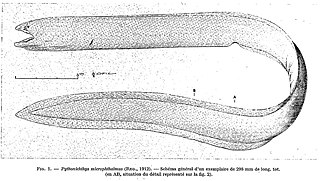
Gadiformes, also called the Anacanthini, are an order of ray-finned fish that include the cod, hakes, pollock, haddock, burbot, rocklings and moras, many of which are food fish of major commercial value. They are mostly marine fish found throughout the world and the vast majority are found in temperate or colder regions while a few species may enter brackish estuaries. Pacific tomcods, one of the two species that makes up the genus Microgadus, are able to enter freshwater, but there is no evidence that they breed there. Some populations of landlocked Atlantic tomcod on the other hand, complete their entire life cycle in freshwater. Yet only one species, the burbot, is a true freshwater fish.

The beardfishes consist of a single extant genus, Polymixia, of deep-sea marine ray-finned fish named for their pair of long hyoid barbels. They are classified in their own order Polymixiiformes. But as Nelson says, "few groups have been shifted back and forth as frequently as this one, and they were recently added to Paracanthoptergii". For instance, they have previously been classified as belonging to the Beryciformes, and are presently considered either paracanthopterygians or the sister group to acanthopterygians. They are of little economic importance.

The Congridae are the family of conger and garden eels. Congers are valuable and often large food fishes, while garden eels live in colonies, all protruding from the sea floor after the manner of plants in a garden. The family includes over 180 species in 32 genera.

The herring smelts or argentines are a family, Argentinidae, of marine smelts. They are similar in appearance to smelts but have much smaller mouths.

Apateodus is a genus of prehistoric marine ray-finned fish which was described by Woodward in 1901. It was a relative of modern lizardfish and lancetfish in the order Aulopiformes, and one of a number of prominent nektonic aulopiforms of Cretaceous marine ecosystems.
The Paw Paw Formation is a geological formation in Texas whose strata date back to the late Albian stage of the Early Cretaceous. Dinosaur remains are among the fossils that have been recovered from the formation.

The Heterenchelyidae or mud eels are a small family of eels native to the Atlantic, Mediterranean, and eastern Pacific.

Calamopleurus is an prehistoric genus of marine holostean ray-finned fish from the Early Cretaceous of South America and northern Africa. It was a relative of the modern bowfin, with both belonging to the family Amiidae.
Casierius is an extinct genus of marine ray-finned fish that lived during the Albian stage of the Early Cretaceous epoch. It was a relative of the modern bonefish in the extinct family Phyllodontidae, although some authorities consider it either a true albulid or a very early eel. It contains a single species, C. heckeli, known from the Glen Rose Formation near Hood County, Texas.
Ampheristus is an extinct genus of prehistoric marine ray-finned fish. It was a basal or stem member of the family Ophidiidae, which contains modern cusk-eels. Fossils are known from worldwide from the Late Cretaceous to the late Paleogene, making it a rather successful survivor of the Cretaceous-Paleogene extinction event.

Anaethalion is an extinct genus of prehistoric marine and freshwater ray-finned fish related to modern tarpons and ladyfish. It is known from the Late Jurassic to the Early Cretaceous of Europe and northeasterrn Asia, roughly encompassing the Tethys Ocean.
Casieroides is an extinct genus of prehistoric freshwater ray-finned fish. It contains a single species, C. yamangaensis from the Early Cretaceous Loia Formation of the Democratic Republic of the Congo.

The Argentiniformes is an order of marine ray-finned fish whose distinctness was recognized only fairly recently. In former times, they were included in the Osmeriformes as suborder Argentinoidei. That term refers only to the suborder of marine smelts and barreleyes in the classification used here, with the slickheads and allies being the Alepocephaloidei. These suborders were treated as superfamilies Argentinoidea and Alepocephaloidea, respectively, when the present group was still included in the Osmeriformes.
Bullichthys is an extinct genus of marine albuliform fish which existed in the Romualdo Formation, Brazil during the Early Cretaceous (Albian) period. The type species is B. santanensis. The genus name references its inflated otic bulla.

Pythonichthys is a genus of eels of the family Heterenchelyidae that occur in tropical waters of the eastern Pacific Ocean off of Panama and in the Atlantic Ocean near the Caribbean Sea and the west coast of Africa. It contains the following described species:

Argentina is a genus of fishes in the family Argentinidae.

Polymixia is the only extant genus of the order Polymixiiformes and family Polymixiidae. It contains 10 species, all of which live in deepwater marine environments. They are found in tropical and subtropical waters of the Atlantic, Indian and western Pacific Oceans. They are bottom-dwelling fish, found down to about 800 m (2,600 ft). Most are relatively small fish, although one species is over 40 cm (16 in) in length. They can be considered "living fossils" due to being the only surviving members of the once-diverse order Polymixiiformes.
Chuhsiungichthys is an extinct genus of ichthyodectiform ray-finned fish that lived in freshwater environments in what is now Yunnan, China, and Kyushu, Japan during the Cretaceous. It differs from its sister genus, Mesoclupea, primarily by having a comparatively more anteriorly-placed dorsal fin.

Yuripopovinidae is an extinct family of Coreoidea Hemipteran true bugs. Member species are known from the Early Cretaceous and early Late Cretaceous of Asia and northern Gondwana. Among the distinguishing characters are "the hemelytral costal vein apically much thickened and pterostigma-like, the corium with two large cells separated by one longitudinal straight vein." Dehiscensicoridae, described from the Yixian Formation of China has been deemed a junior synonym of Yuripopovinidae per Du et al. (2019). The family was named after Russian paleoentomologist Yuri Alexandrovich Popov.

The Dercetidae are an extinct family of aulopiform fish that are known from the Late Cretaceous to the early Paleocene. They are among the many members of the diverse, extinct suborder Enchodontoidei, which were dominant during the Cretaceous.












